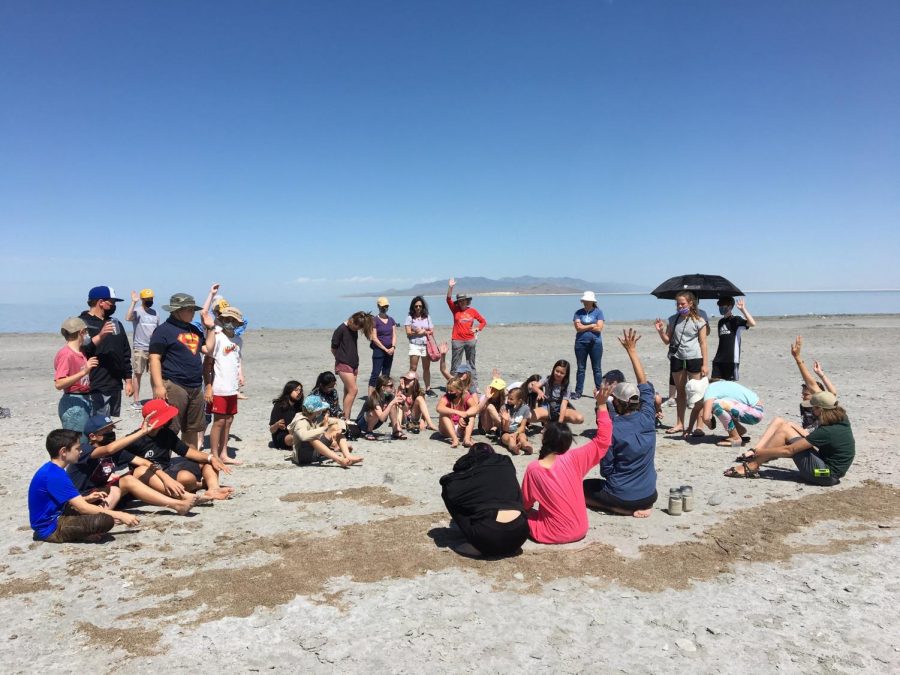Shadley: Expand Outdoor Education This Fall
A fifth-grade science class joins FRIENDS of Great Salt Lake on a field trip to learn about the lake’s ecosystem at Antelope Island State Park on June 24, 2020. (Photo by Gwen Christopherson | The Daily Utah Chronicle)
August 12, 2021
Low vaccination rates and the emerging Delta variant have caused COVID-19 cases to rise in Salt Lake City. As in-person schooling resumes, Salt Lake City’s school district must once again utilize COVID-19 mitigation practices to ensure the safety of students, teachers, staff and families.
Another semester of remote learning is unfavorable as no one wants the online school “learning loss” to continue. However, Salt Lake City decided to only “strongly encourage” mask-wearing among students and staff for the schools in the district.
Masks, like all pandemic guidelines, lower the risk of contracting the virus. If Salt Lake City officials are unwilling to enforce a mask mandate, they have an alternate, more politically palatable, way to mitigate the spread. The pandemic offers Salt Lake City an opportunity to expand outdoor environmental education.
Doing so would allow teachers to teach students in a more pandemic safe setting, offer students a different style of learning and prepare students to succeed in the changing climate they’ve inherited.
The Benefits of Environmental Education
Throughout the pandemic, any activity or gathering has generally been considered safer if it was held outdoors. Moving classes outside will reduce the risk of COVID-19 for teachers and students, but it also provides educational and mental health benefits. Those benefits include increased creativity and focus, greater retention and greater equity in the classroom.
Alex Porpora, the Executive Director of the Utah Society for Environmental Education, discussed the ways in which environmental education can help Salt Lake City students. She said that education offers all students “the opportunity to engage in something different” from what they normally experience in the classroom, and while that’s valuable for everyone, it’s particularly valuable for students who are better suited for that style of learning. It allows those students to have “their time to shine.”
At the end of the last school year, Porpora told me about an experience she had leading an outdoor class of sixth graders. During their “nature journaling” activity, one of the students came up to Porpora and asked if they “can do this every day.” That student may have had a much more difficult time connecting with those same science concepts sitting in the back of a classroom, but because they got to engage in this environmental education opportunity, they developed an affinity for natural science.
That newfound passion and interest translates to improvements in the classroom. Porpora said, “outdoor classrooms and environmental education aren’t meant to replace existing curricula, but to support it.” At a time when most students have fallen behind, environmental education can offer them a chance to catch up, and it will keep them safer in the process.
How Salt Lake City Can Expand Environmental Education in Schools
Environmental education comes in many forms. It can be as simple as “reading outside” or it can involve “building an entire outdoor classroom.” While the former requires little effort on the part of faculty and staff (assuming the school has an adequate schoolyard), the latter requires significantly more resources.
Luckily, the pandemic has created an opportunity for Salt Lake City schools to easily expand their environmental education infrastructure. The CARES Act provided Elementary and Secondary Schools with tens of billions of dollars that they can spend to address the ongoing impacts of the COVID-19 pandemic. In other states, Porpora has seen school districts use that money to pay for “teacher professional development to take students outdoors,” “Green School initiatives” and even “outdoor classrooms.” Salt Lake City schools should look to do the same.
Utah already has a unique environmental education program in place, and we should also look to use the CARES Act money to fund the expansion of this program. iSEE, Informal Science Education Enhancement, is a collaboration among non-profit organizations in Utah to “provide one hour school outreach programs to schools across the entire state,” according to Porpora.
Regardless of where those students are in the state, iSEE ensures that they get at least one hour of informal environmental education. Currently, the Utah State Board of Education administers funds to ensure the program runs, but the additional funding could be used to provide more consistent environmental education programs across the state.
Porpora mentioned that one of the skills that environmental education develops is the ability to “deeply observe” the natural world. The pandemic has created a situation where Salt Lake City can expand environmental education and turn it into an integral component of our public school curriculum. However, all that depends on their ability to recognize the opportunity. Let’s hope they’ve had some environmental education.









